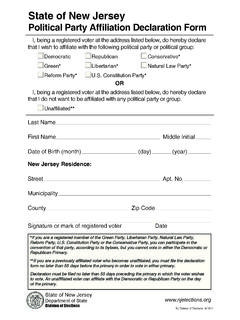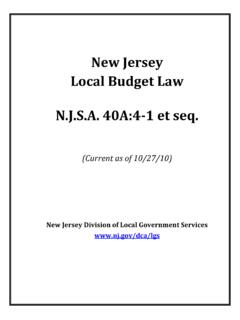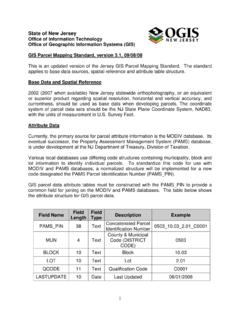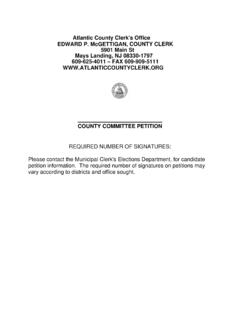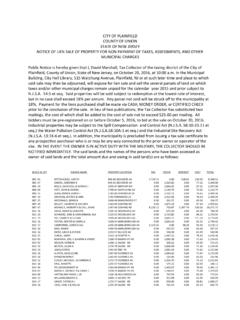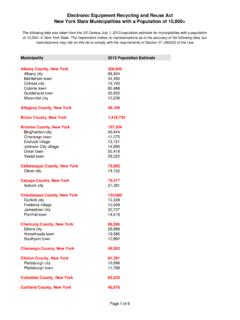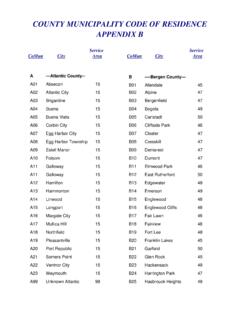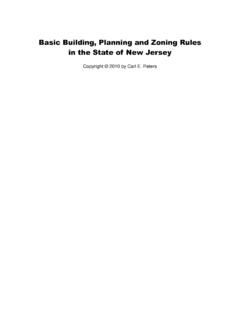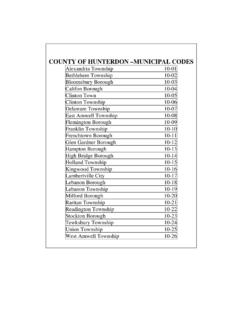Transcription of CHANGE IN NEW JERSEY MUNICIPAL ORGANIZATION
1 CHANGE IN NEW JERSEY MUNICIPAL ORGANIZATION Center for Government Services Edward J. Bloustein School of Planning and Public Policy Rutgers University June 2006 2 CHANGE in New JERSEY MUNICIPAL ORGANIZATION Motivation for 1 Growth of MUNICIPAL 1 Frustration with the Existing 1 Perceived Lack of 2 Political 2 Methods of Changing the Form of 2 The Direct Petition 4 Commission Form of 4 MUNICIPAL Manager Form of 4 Optional MUNICIPAL Charter 5 The Work of a Charter Study 6 Establishing the 6 ORGANIZATION of the 6 The Charter Commission 7 Phases of the Charter Commission s 8 The First Study Phase The Present Form of 9 Choice of 10 The Interview 11 Trends of the Present Local 12 Public Hearing on the Present Form of 13 Conclusion of the First Study 14 The Second Study Phase Alternative Forms of 14 Informational 15 Public Hearing on Alternative Forms of
2 16 The Third Study Phase 17 Types of Conclusions and 18 Preparation of the 18 Contents of the 19 Printing and Distribution of the 20 Charter Commission Activities After Filing of the 21 Subsequent Charter Study 22 Abandonment of an Optional Form of 22 3 Amendment of a Charter Under the Optional MUNICIPAL Charter 23 Use of Runoff 23 Special 24 Initiating the 24 Responsibilities of the MUNICIPAL Chief 25 Action by the 25 Action by the 26 Final Local 26 Effective 26 4 CHANGE in New JERSEY MUNICIPAL Organization1 Motivation for CHANGE How and why do residents of a community become involved in advocating a CHANGE in local government ORGANIZATION ? Local government ORGANIZATION is not usually a major topic of conversation among most people.
3 Although the services of local government may be close to the residents, the subjects of ORGANIZATION and procedures are relatively abstract, and attention may easily be diverted by the emphasis placed by the media on the more glamorous aspects of state and federal government and international affairs. Nevertheless, people do get involved, and CHANGE does take place. While a multitude of factors may provide motivation, four seem to be most important, and they are discussed below, not necessarily in order of importance. Growth of MUNICIPAL Responsibilities As a community grows in population, the size and complexity of local government increases. In many cases, the older forms of government may then be found to be inadequate, particularly in terms of providing for some central control and coordination of the new offices and agencies that must be established to meet the growing responsibilities of the municipality . Frustration with the Existing Government A second source of motivation for CHANGE comes from a sense of frustration that citizens may experience in dealing with their existing form of government.
4 This often begins with concern about a particular issue, ranging from such dramatic events as a new housing development or shopping center, or a major tax increase, to more mundane issues, such as a failure in garbage collection. When the existing government fails to act with the expected degree of responsiveness and professionalism, the concern of the individual citizens frequently is transferred from the original issue to the deficiencies of the system itself. A second form of frustration comes from within the MUNICIPAL government itself, when part-time elected officials find themselves swamped with the operational details of administering the day-to-day activities of the MUNICIPAL government. Such demands on the time of the governing body member can lead to divided loyalties among private employment, family responsibilities, and public obligations. The result may be a search for a form of government in which administrative functions are professionalized by the appointment of full-time persons, leaving the part-time elected official free to consider the broader policy issues facing the community.
5 1 Adapted and updated from Ernest C. Reock, Jr. and Raymond D. Bodnar, The Changing Structure of New JERSEY MUNICIPAL Government, New JERSEY county and MUNICIPAL Government Study Commission, April 1985. 5 Perceived Lack of Representation When citizens begin to believe that their local government officials do not represent them adequately, attention may turn to a CHANGE in form of MUNICIPAL government as a solution. Such a belief often develops when all members of the governing body are elected at large from the entire municipality and a disproportionate number come from one segment of the community. If the sections of the community considered under-represented can be defined in geographic terms, then a movement for ward representation may develop in order to spread the elective offices more widely throughout the municipality . Another variation is found when citizens realize that they have a form of government in which their primary elected representative the mayor is not elected directly by the voters, but is selected by and from among his or her peers on the MUNICIPAL governing body.
6 The tradition of directly electing the chief executive is so clearly recognized at the national level with the president, and at the state level with the governor, that a different approach locally sometimes triggers a feeling that adequate provision for representation has not been made. Finally, where a substantial portion of a community is outraged by some action of the MUNICIPAL governing body or mayor there may be a feeling that the public officials of the community are not listening to their constituents, and the demand may be translated into a search for a form of government where the voters have a direct voice in public policy through the devices of initiative and referendum. Political Control Lastly, but certainly not least in importance, is a desire by political factions that are out of office to use a CHANGE in form of government to enhance their position. The history of CHANGE in New JERSEY communities is marked by frequent demands for MUNICIPAL reorganization by the outs, since any major CHANGE in charter results in all MUNICIPAL offices being vacated and new elections being held.
7 Any one of these factors may spark a movement for CHANGE in form of MUNICIPAL government. The potential for actually bringing about the CHANGE is far higher when more than one of the motivations coincide in a community at the same time. Methods of Changing the Form of Government The laws of New JERSEY permit two basic statutory methods for initiating a CHANGE in the form of MUNICIPAL government. One is the direct petition method; the other is the election of a charter study commission. The direct petition method is the oldest, having precedents going back into the nineteenth century. It is most appropriate when there is believed to be a consensus in the community as to the form of government that would be best for that municipality . The laws for each optional form of government establish the number of signatures that must be gathered on a petition in order to 6 place on the ballot a question as to whether the existing form of government should be abandoned and replaced with a specified new form.
8 A referendum is held according to a schedule contained in the law, and the decision of the voters prevails. More details will be presented below. The second method of CHANGE is through the election of a charter study commission. This method is most appropriate when there is dissatisfaction with the present form of government, but there is no obvious consensus as to what form should replace it. The charter study commission approach is authorized only under the Optional MUNICIPAL Charter Law of 1950 (OMCL)2. The question of whether there shall be a charter study commission can be placed on the ballot either through a petition or through the enactment of an ordinance by the existing MUNICIPAL governing body. At the same time that the voters decide whether there will be such a commission, they vote for the members, with the five persons receiving the highest votes becoming the members if the commission is authorized. A charter study commission under the OMCL may recommend that the municipality CHANGE to one of the OMCL forms of government, in which case the question of whether that form should be adopted must be placed on the ballot for referendum of the voters.
9 The charter study commission also may recommend a special charter, with further action being required, but the study commission may not place on the ballot a question dealing with any other forms of MUNICIPAL government that are not a part of the OMCL. In general, the two approaches cannot proceed simultaneously; priority goes to the first official action that is taken3. Thus, if a direct petition for CHANGE has been filed and has the proper number of valid signatures, an ordinance for a charter commission referendum has no effect. Persons or groups considering a campaign for CHANGE in their form of government should be aware that expenditures intended to influence the vote on a public question, as well as the expenditures for charter commission candidates, come within the scope of the New JERSEY Campaign Contributions and Expenditures Reporting Act. Accurate accounts must be kept from the beginning of such a campaign in case the total expenditures exceed the limit that will require the filing of official reports4.
10 Another approach to CHANGE has been used in a number of municipalities in recent years. This is the appointment by the mayor or the governing body of a charter study committee as distinguished from a charter study commission. A charter study committee is strictly an advisory body, having no basis in state law. While its members may conduct the same kind of a study of the form of government as a statutory commission under the OMCL, the advisory committee has no authority to place its recommendations on the ballot. If such a committee concludes that a new form of MUNICIPAL government is appropriate, it must proceed with the direct petition 2 40:69A-1 et seq. 3 40 4 For more information, contact the New JERSEY Election Law Enforcement Commission, 609-292-8700, 7 method or with action to initiate a statutory charter study commission, gathering enough signatures to place the question on the ballot.






